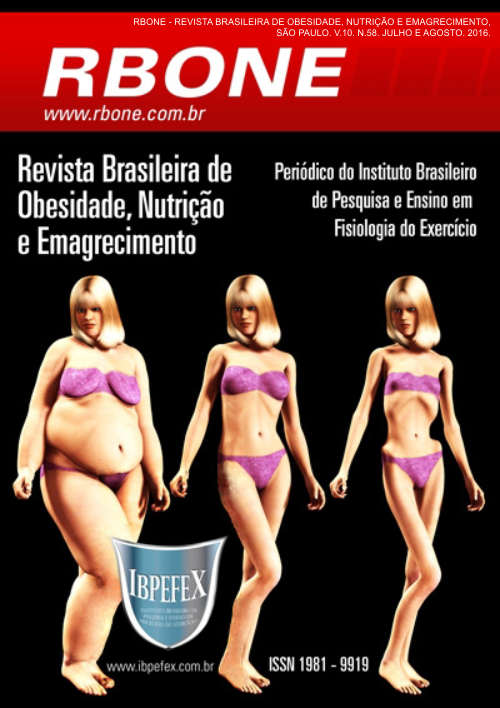Identification of changes in mechanisms sensory, no standard food and body of ex-smokers
Abstract
The objective of the research was to investigate the changes in sensory mechanisms in the eating pattern and body of adult ex-smokers, and their perception of the influence of these aspects on quality of life. The study is qualitative and quantitative, with cross-sectional, observational character, conducted from february to march 2015. It evaluated 33 people former smokers. The average age of participants was 52.76 years, 51.5% female. The termination process led to tangible changes, whose average weight gain was 11,67Kg; and sensory changes, which indicated that 78.8% of respondents had a positive change in taste, and 69.7% had positive change in smell. As for the change in food preference, 45.45% of the participants reported eating more fruits and vegetables after you stop smoking. All survey participants realized an improvement in quality of life within two months to a year. This research, through the recorded results, reinforces similar studies in order to establish the thesis that improvements to healthare numerous for those who quits smoking.
References
-Allen, S. S.; Allen, A. M.; Mooney, M.; Bade, T. Short-term weight gain by menstrual phase following smoking cessation in women. Eat Behav. Vol. 10. Núm. 1. p. 52-55. 2009.
-Burke, B.; Hazuda, M.P.; Stern, M.P. Rising trend in obesity in Mexican Americans and non-Hispanic whites: is it due to cigarette smoking cessation? Int J Obes Relat Metab Disord. Vol. 24. Num. 12. p. 1689-1694. 2000.
-Chiolero, A.; e colaboradores. Consequences of smoking for body weight, body fat distribution, and insulin resistance. Am J Clin Nut. Vol. 87.p. 801-809. 2008.
-CONICQ. Comissão Nacional para Implementação da Convenção-quadro para o Controle do Tabaco.2003.
-Ferrara, C. M.; Kumar, M.; Nicklas, B.; McCrone, S.; Goldberg, A. P. Weight gain and adipose tissue metabolism after smoking cessation in women. Int J Obes Relat Metab Disord. Vol. 25. Núm. 9. p. 1322-1326. 2001.
-Hungria, H. Otorrinolaringologia. 8ª edição. Guanabara Koogan. 2000.
-Klein, L. C.; Corwin, E. J.; Ceballos, R. M. Leptin, hunger, and body weight: Influence of gender, tobacco smoking, and smoking abstinence. Addict Behav. Vol. 29. Núm. 5. p. 921-927. 2004.
-Lemos-Santos, M. G.; Gonçalves-Silva, R.M.V.; Botelho, C. Tabagismo, composição corporal, distribuição da adiposidade e ingestão alimentar em fumantes, não -fumantes e ex -fumantes. A Folha Médica. Vol. 119. Núm. 3. p. 23-31. 2000.
-Lipschitz, D. A. Screening for nutritional status in the elderly. Prim Care. Vol. 21. Núm. 1. p. 55-67. 1994.
-OPAS, Organização Pan-Americana de Saúde. Cartilha sobre Doenças Crônicas Associação Brasileira para Estudo da Obesidade e da Síndrome Metabólica. 2013.
-Neto, F. X. P.; Targino, M. N.; Peixoto, V. S.; Alcântara, F. B.; Jesus, C. C.; Araújo, D. C.; e colaboradores. Anormalidades sensoriais: olfato e paladar. Arq Int Otorrinolaringol. Vol. 15. Núm. 3. p. 350-358. 2010.
-Novello, M. B.; Novello, L. B. Relação entre a parada do hábito de fumar e a mudança de peso. Arquivos catarinenses de Medicina. Vol. 29. Núm. 1-4. p. 3. 2000.
-Pomerleau, C. S.; Pomerleau, O. F.; Namenek, R. J.; Mehringer, A. M. Short-term weight gain in abstaining women smokers. J Subst Abuse Treat. Vol.18. Núm. 4. p. 339-342. 2000.
-UNIFESP. Centro Brasileiro de Informação sobre Drogas Psicotrópicas. São Paulo. 2001.
-U.S. Department Of Health And Human Services. Smoking Cessation. Special Populations and Topics. Rockville: Ahcpr, 1996. N.5.P.6769. In: Azevedo, R. C.S.; Higa, C.M.H.; Assumpção, I.S.A.; Frazatto, C.R.G.; Fernandes, R.F.; Goulart, W.; Botega, N.J.; Boscolo, M.M.; Sartori, R.M. Grupo terapêutico para tabagistas: resultados após seguimento de dois anos. Campinas, SP. UNICAMP. 2009.
-Williamson, D. F. Smoking cessation and severity of weight gain in a national cohort. N Engl J Med. Vol. 324. p. 739-745. 1991.
-World Health Organization Obesity. Preventing and managing the global epidemic: report of a WHO Consultation. Geneva, World Health Organization. Technical Report Series, 894. 1998.
-World Health Organization. Reducing risks, promotion healthy life: the world health report 2002 [online]. Geneva (ch): world health organization; 2002 [cited 2012 jul 03]. Disponível em: http://www.who.int/whr/2002/en/whr02_en.pdf. Acesso em: 7/10/2014.
-Zappacosta, B.; Persichilli, S.; De Sole, P.; Mordente, A.; Giardina, B. Effect of smoking one cigarette on antioxidant metabolites in the saliva of healthy smokers. Arch Oral Biol. Vol. 44. Núm. 6. p. 485-488. 1999.
-Zappacosta, B.; Persichilli, S.; Mordente, A.; Minucci, A.; Lazzaro, D.; Meucci, E.; e colaboradores. Inhibition of salivary enzymes by cigarette smoke and the protective role of glutatione. Hum Exp Toxicol. Vol. 21. Núm. 1. p. 7-11. 2002.
Authors who publish in this journal agree to the following terms:
- Authors retain the copyright and grant the journal the right of first publication, with work simultaneously licensed under the Creative Commons Attribution License BY-NC which allows the sharing of the work with acknowledgment of the authorship of the work and initial publication in this journal.
- Authors are authorized to enter into additional contracts separately for non-exclusive distribution of the version of the work published in this journal (eg, publishing in institutional repository or book chapter), with acknowledgment of authorship and initial publication in this journal.
- Authors are allowed and encouraged to post and distribute their work online (eg, in institutional repositories or on their personal page) at any point before or during the editorial process, as this can bring about productive change as well as increase impact and impact. citation of published work (See The Effect of Free Access).






